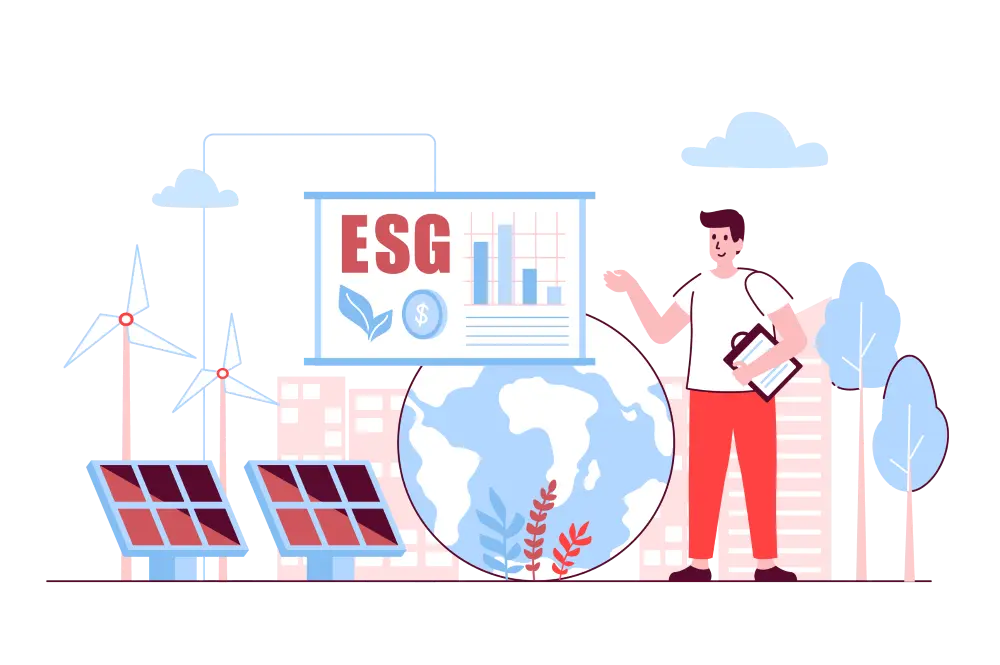Integrating ESG Principles into Project Management: A Sustainable Approach
August 5, 2024 5 min

What is ESG and Why Does it Matter?
In recent years, ESG (Environmental, Social, and Governance) principles have shifted from being a niche concern to a core business consideration. But what does ESG really mean? Essentially, ESG refers to the three key areas companies are encouraged to focus on when considering their broader impact on society.
- Environmental: How does a company manage its environmental impact, including carbon footprint, energy consumption, waste management, and biodiversity?
- Social: This encompasses how a business interacts with its employees, customers, suppliers, and the broader community. It includes human rights, labor practices, and community engagement.
- Governance: Governance factors deal with how a company is run—this includes corporate transparency, executive compensation, board diversity, and ethical decision-making.
But why is this important for project managers? ESG principles are becoming a vital component of long-term strategy, influencing not just what projects are pursued, but how they are managed. For project managers, the ability to integrate these principles into daily work is quickly becoming non-negotiable. This is because stakeholders—whether customers, investors, or regulators—are increasingly looking for businesses that can demonstrate responsible, sustainable practices.
To further explore the significance of ESG principles in project management, watch the following video by Anne Jacob. It provides an engaging overview of ESG concepts and exemplifies how these principles are applied in various industries. This visual resource will deepen your understanding and illustrate the real-world impact of integrating ESG into project management.
Understanding ESG Principles in Project Management
What ESG Really Means
To get to grips with ESG, it’s essential to understand what each component entails in project management and how these factors influence decision-making. Here’s a breakdown:
- Environmental: This involves all the ways a project can minimize its negative impact on the environment. Think carbon emissions, energy efficiency, resource use, and pollution prevention.
- Social: Projects must consider how they affect the people involved—from workers to communities. Does the project support diversity and inclusion? Is it ethically sound? Does it contribute to or harm local communities?
- Governance: This is all about transparency, accountability, and ethics in management practices. Does the project comply with regulations? Is the leadership transparent and accountable to stakeholders?
ESG isn’t just a “nice-to-have”—it’s increasingly a requirement. Emerging standards and regulations are pushing businesses to align with ESG principles. For instance, the European Union’s Corporate Sustainability Reporting Directive (CSRD) is forcing large companies to disclose detailed information on sustainability issues. In the U.S., similar trends are emerging, with investors like BlackRock demanding greater corporate responsibility .
Why ESG Matters Across All Industries Whether you’re in tech, construction, finance, or manufacturing, ESG principles are rapidly becoming relevant across all sectors. Construction companies, for instance, must consider sustainable sourcing and waste management, while tech companies need to manage their energy use in data centers. The financial industry, meanwhile, faces growing scrutiny over investment decisions, with investors increasingly favoring ESG-conscious firms .
The Role of Project Management in ESG
Aligning Organizational Goals with ESG Commitments
A key responsibility of project management is to align business objectives with ESG commitments. Project managers play a crucial role in this by ensuring that every project not only meets financial and operational goals but also aligns with ESG principles. This alignment is critical for future-proofing businesses.
Project Management Frameworks for ESG
One useful framework for integrating ESG into project management is the PMI’s Sustainability Checklist, which can help guide project managers in integrating sustainability at each phase of the project life cycle.
Implementing ESG in Project Management Processes
-
The Initiation Phase: Setting ESG Priorities:
This is where project managers assess the feasibility of a project, and in today’s world, ESG considerations are paramount. Feasibility studies should include an analysis of how the project will impact the environment, people, and governance structures. At this stage, it’s also crucial to conduct a stakeholder analysis. ESG principles require you to go beyond traditional stakeholder mapping by considering not just shareholders and executives but also local communities, environmental activists, and government bodies.
-
Planning Phase: Building ESG into KPIs:
The next step is planning, which should include setting ESG-specific goals and KPIs. It’s not enough to say, “We’ll minimize waste.” You need measurable goals: How much waste reduction are you targeting? What are your carbon emissions limits? How will you track diversity within the project team? Risk management is another area where ESG principles come into play. You should plan for potential ESG-related risks—such as environmental protests, regulatory changes, or supply chain disruptions—and have mitigation strategies ready.
-
Execution Phase: Tools for ESG Integration:
Once the project is underway, the focus shifts to execution. At this stage, ESG monitoring tools become critical. For example, tools like Sustainalytics or EcoVadis can help track ESG metrics in real-time. You’ll also want to establish protocols for continuous ESG monitoring throughout the project lifecycle. Regular updates and reports on ESG metrics—whether it's resource consumption or worker safety—help ensure that the project stays on track.
-
Monitoring and Controlling Phase: Ensuring Compliance:
Constant monitoring is essential to ensure that the project adheres to ESG guidelines. It’s not just about setting goals—it’s about measuring progress and making necessary adjustments. Use ESG audits and reporting mechanisms to track performance against KPIs. This ensures transparency, which is vital for stakeholders and regulatory bodies.
-
The Closure Phase: Measuring ESG Success:
When a project wraps up, it’s time to evaluate its success—not just in financial terms but also in how well it met its ESG objectives. This could include anything from waste reduction and energy efficiency to improved social outcomes for the community involved.
Overcoming Challenges in ESG Integration
Common Roadblocks to ESG Integration
Integrating ESG principles into project management is not without its challenges. Some common barriers include:
- Resistance to Change: People may resist adopting new methodologies or frameworks, especially if they perceive ESG as an unnecessary burden.
- Lack of Knowledge: Many project managers are still unfamiliar with how to integrate ESG principles effectively.
- Resource Constraints: Sometimes, ESG initiatives can seem costly or resource-heavy, especially in the short term.
Strategies for Overcoming ESG Challenges
The good news is that there are ways to overcome these challenges. One approach is to educate project teams on the importance of ESG and the long-term benefits it brings. Training and development programs focused on sustainability can go a long way.
It’s also important to start small. Not every project needs to have a massive ESG component right away. Start by incorporating basic ESG principles and gradually scale up as the team becomes more comfortable with the concepts .
Leadership’s Role in Promoting ESG
None of this can happen without strong leadership. Project managers need to advocate for ESG initiatives at every level, and executives need to back these efforts with resources and support.
Benefits of ESG Integration in Project Management
ESG integration in project management is not just a trend; it’s a fundamental shift that can significantly enhance both value and return on investment (ROI). Let’s break down how ESG-driven projects can create long-term value.
| Benefit | Description |
|---|---|
| Enhanced Value and ROI | ESG-driven projects add value by increasing the overall worth of other assets, aligning with sustainable development goals (SDGs), and improving the bottom line over time. |
| Companies that perform well in ESG practices often attract and retain customers, investors, and employees who prioritize sustainability. | |
| Risk Management | ESG frameworks enhance risk mitigation strategies. They help companies become more resilient to environmental disruptions and economic downturns. |
| Improved capabilities in ESG also mean better human resource management and stronger ties with local communities, which contribute to overall stability. | |
| Reputation and Market Position | Implementing ESG practices strengthens a company's brand image and competitiveness in the market. |
| As society shifts towards sustainability, companies that engage in responsible and ethical operations are more likely to attract stakeholders and enhance their market position. | |
| Innovation and Knowledge Sharing | ESG encourages innovation by fostering a culture of knowledge-sharing with suppliers and local communities, leading to improved access to resources and infrastructure. |
| By promoting sustainable practices, companies can drive efficiency and creativity, positioning themselves as leaders in their industries. |
Conclusion
Incorporating ESG principles into project management isn’t just a trend—it’s a necessity for sustainable business growth. As stakeholder expectations evolve, project managers must adapt by embedding these principles into every stage of the project lifecycle.
The benefits are clear: enhanced reputation, better risk management, and long-term value creation. So, whether you’re a seasoned project manager or just starting, integrating ESG should be at the top of your priority list. Ready to get started? Dive into the world of sustainable project management today!

